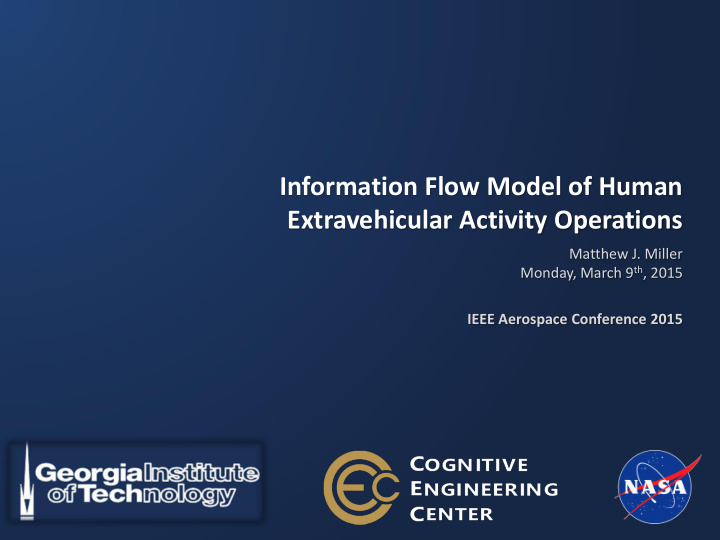



Information Flow Model of Human Extravehicular Activity Operations Matthew J. Miller Monday, March 9 th , 2015 IEEE Aerospace Conference 2015
Research Motivation Mars 3 min Closest (~55,000,000 km) 22 min Farthest (~400,000,000 km) Near Earth Object (NEO) How should mission support responsibilities be ~1+ min (variable) allocated between ground and the spacecraft in the presence of significant time delay? Moon 1.3 sec (~40,000 km) One-Way Destinations Time Delay <1 ms ISS (~400 km) 2
Human Extravehicular Activity (EVA) Construction Inspection How are EVAs actually performed? Who is involved? What is the communication dynamic like between EVA operators? Life-Support Exploration Repair EVA is a mission critical component of human spaceflight EVA is a complex, highly orchestrated activity, requiring substantial effort from both astronauts and support personnel Pate, 2011 IEEE Aerospace Conference 2015 – 03/09/2015 3
Preliminary Field Study Location: NASA Johnson Space Center (Summer 2014) Participants: Subject-matter experts within the EVA community Format: Semi-structured interviews, lasting 45 to 60 minutes Interview Objectives 1. Overview of the EVA development and execution process 2. Identify the key personnel involved in EVA and their respective roles and responsibilities 3. Gain an understanding of information flow between personnel during EVA Internal NASA Data Sources Data Formats: Operational Handbooks, Training Manuals, Archived EVA audio/video footage, EVA WIKI Output • Information flow model of current ISS EVA Operations • Communication Analysis of Apollo 16 - EVA 4 IEEE Aerospace Conference 2015 – 03/09/2015 4
Information Flow Model of EVA Work Domain EVA Crew (2) IVA: Intravehicular Activity IVA Crew (1) “The Actuators” In-Space Personnel Ground IV (1) Mission Control Center CAPCOM (1) “The Mission EVA Lead (1) Front Control Room Directors” Flight Director (1) (MCC FCR) OTHER (16+) Tasks & Hardware (1-2) “The Raw Spacesuit (1-2) MCC Multi-Purpose Support Air Lock (1-2) Data Crunchers” Room (MPSR) MPSR Support Data Type Contacts Facilities Audio, Text, Video, & Telemetry Audio and Text IEEE Aerospace Conference 2015 – 03/09/2015 5
Operational Challenges within EVA Work Domain Comm. Relay outages - Video In-Space Personnel Lack of knowledge and poor comm. - Audio can lead to improper task execution - Telemetry (EVA replanning, System updates) - EMU Data Mission Control Center Front Control Room Note: EV crew can have poor spatial (MCC FCR) awareness Data/Trend Monitoring - Information overload - Inadequate knowledge MCC Multi-Purpose Support transfer Room (MPSR) - Over reliance on support teams MPSR Support Data Type Contacts Facilities Audio, Text, Video, & Telemetry Audio and Text IEEE Aerospace Conference 2015 – 03/09/2015 6
Gaining some Historical Context – Apollo 16 EVA 4 + Approach Qualitative Data Analysis using a structured coding scheme • Data pulled from Lunar Surface Journal • Atlas.ti7 QDA software + EVA Details Approx. 1 hour in duration Performed beyond LEO Objectives • Retrieve film cassette • Conduct the Microbial Ecology Evaluation Device (MEED) experiment Complete written transcript available http://www.lpi.usra.edu/lunar/missions/apollo/apollo_16/images/spacewalk_lg.jpg • Only crew and CAPCOM IEEE Aerospace Conference 2015 – 03/09/2015 7
EVA Air-to-Ground Communication Analysis 600 EVA POST - EVA PRE - EVA 500 EV Crew (Mattingly) Instance Count 400 IV Crew (Young) 300 200 IV Crew (Duke) 100 Crew/Crew Communications 0 600 500 CAPCOM (Peterson) Instance Count 400 300 CAPCOM (Hartsfield) 200 100 Crew/Ground 0 Communications Time (s) IEEE Aerospace Conference 2015 – 03/09/2015 8
Communication Content Analysis 100% 90% Acknowledge Percentage of Comm Instances 80% Update 70% Reminder 60% Clarification 50% Request Response 40% 30% Request 20% Query Response 10% Query 0% 1 2 3 4 (IVA) (EVA) (IVA) (CAPCOM) IEEE Aerospace Conference 2015 – 03/09/2015 9
Conclusions and Future Work + Future human spaceflight missions will be subjected an asynchronous communication environment between crew and ground Implication: Crew must become more autonomous + Extravehicular Activity is a mission critical capability to be used as a case study work domain + In this Study: EVA specific operators were identified – their roles and responsibilities explained Current informational flow disturbances were identified Communication analysis was performed to assess the content of communication needs and demands during an EVA + Implications for the future Decision support systems have been identified in the literature as one possible solution to enable crew capability in an asynchronous environment Ph.D. Thesis Proposal Presentation - 12/16/2014 10
Questions? Acknowledgements This work is sponsored by NASA Space Technology Research Fellowship - Grant # NNX13AL32H. Ph.D. Thesis Proposal Presentation - 12/16/2014 11
Recommend
More recommend